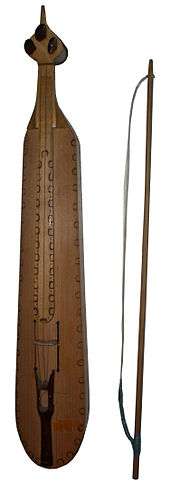Lavta
.jpg)
The lavta is a plucked string instrument from Istanbul. It has a small body made of many ribs using carvel bending technique, looking like a small (Turkish) ud, gut strings like an ud but only 7 strings in 4 courses and tunable: A dd gg c'c' (like the ud), or sometimes A dd aa d'd' (in intervals of 5ths like laouto as well as 4ths); also tuned to Turkish Bolahenk tuning C G D A which is G D A E concert pitch. The adjustable frets are tied bits of gut on the fingerboard, at the microtonal intervals of the makam system, a significant difference from both fretless ud and 12-frets to the octave laouto, making its fretboard more related to instruments like tanbur. The bridge usually has mustache-shaped ends. The fingerboard is flush with the soundboard, which is often unvarnished, and has a carved and inlaid rosette. Some lavta have a pegbox like the ud (angling down), others more like a guitar (or like a buzok or Greek laouto). The tuning pegs are shaped like those of the violin, with 3 on the right side and 4 on the left side of the open tuning head.
Known as a lavta (լավտա) in Armenian, also occasionally called Politiko Laouto (Lute from Constantinople) in Greek, is an instrument that was popular in the early 20th century, particularly among the Greek and Armenian communities of Istanbul, but also the Turkish community, it was one of the many instruments played by noted Turk Tanburi Cemil Bey. It was gradually replaced by the ud and survived until this day. From the 1980s there has been a revival of interest in this instrument, and now you can find the lavta again both in Turkey and in Greece.
Right hand technique is similar to an oud, with a long thin plectrum.
